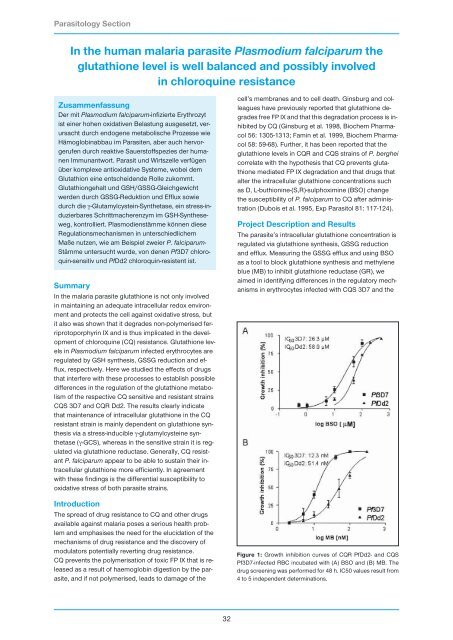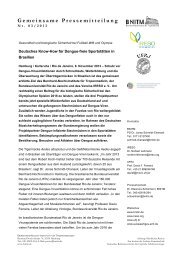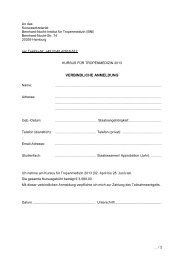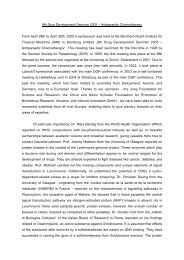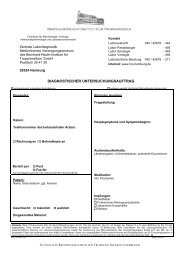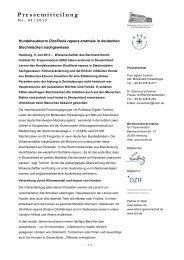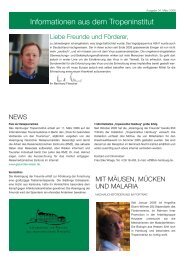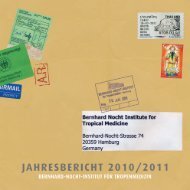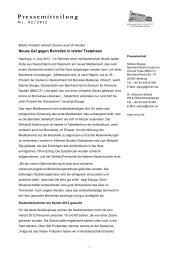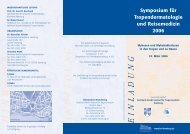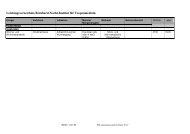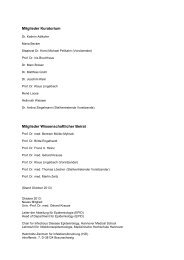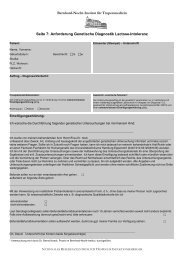Research Group Heussler (Malaria I) - Bernhard-Nocht-Institut für ...
Research Group Heussler (Malaria I) - Bernhard-Nocht-Institut für ...
Research Group Heussler (Malaria I) - Bernhard-Nocht-Institut für ...
Create successful ePaper yourself
Turn your PDF publications into a flip-book with our unique Google optimized e-Paper software.
Parasitology Section<br />
In the human malaria parasite Plasmodium falciparum the<br />
glutathione level is well balanced and possibly involved<br />
in chloroquine resistance<br />
Zusammenfassung<br />
Der mit Plasmodium falciparum-infizierte Erythrozyt<br />
ist einer hohen oxidativen Belastung ausgesetzt, verursacht<br />
durch endogene metabolische Prozesse wie<br />
Hämoglobinabbau im Parasiten, aber auch hervorgerufen<br />
durch reaktive Sauerstoffspezies der humanen<br />
Immunantwort. Parasit und Wirtszelle verfügen<br />
über komplexe antioxidative Systeme, wobei dem<br />
Glutathion eine entscheidende Rolle zukommt.<br />
Glutathiongehalt und GSH/GSSG-Gleichgewicht<br />
werden durch GSSG-Reduktion und Efflux sowie<br />
durch die γ-Glutamylcystein-Synthetase, ein stress-induzierbares<br />
Schrittmacherenzym im GSH-Syntheseweg,<br />
kontrolliert. Plasmodienstämme können diese<br />
Regulationsmechanismen in unterschiedlichem<br />
Maße nutzen, wie am Beispiel zweier P. falciparum-<br />
Stämme untersucht wurde, von denen Pf3D7 chloroquin-sensitiv<br />
und PfDd2 chloroquin-resistent ist.<br />
Summary<br />
In the malaria parasite glutathione is not only involved<br />
in maintaining an adequate intracellular redox environment<br />
and protects the cell against oxidative stress, but<br />
it also was shown that it degrades non-polymerised ferriprotoporphyrin<br />
IX and is thus implicated in the development<br />
of chloroquine (CQ) resistance. Glutathione levels<br />
in Plasmodium falciparum infected erythrocytes are<br />
regulated by GSH synthesis, GSSG reduction and efflux,<br />
respectively. Here we studied the effects of drugs<br />
that interfere with these processes to establish possible<br />
differences in the regulation of the glutathione metabolism<br />
of the respective CQ sensitive and resistant strains<br />
CQS 3D7 and CQR Dd2. The results clearly indicate<br />
that maintenance of intracellular glutathione in the CQ<br />
resistant strain is mainly dependent on glutathione synthesis<br />
via a stress-inducible γ-glutamylcysteine synthetase<br />
(γ-GCS), whereas in the sensitive strain it is regulated<br />
via glutathione reductase. Generally, CQ resistant<br />
P. falciparum appear to be able to sustain their intracellular<br />
glutathione more efficiently. In agreement<br />
with these findings is the differential susceptibility to<br />
oxidative stress of both parasite strains.<br />
Introduction<br />
The spread of drug resistance to CQ and other drugs<br />
available against malaria poses a serious health problem<br />
and emphasises the need for the elucidation of the<br />
mechanisms of drug resistance and the discovery of<br />
modulators potentially reverting drug resistance.<br />
CQ prevents the polymerisation of toxic FP IX that is released<br />
as a result of haemoglobin digestion by the parasite,<br />
and if not polymerised, leads to damage of the<br />
32<br />
cell’s membranes and to cell death. Ginsburg and colleagues<br />
have previously reported that glutathione degrades<br />
free FP IX and that this degradation process is inhibited<br />
by CQ (Ginsburg et al. 1998, Biochem Pharmacol<br />
56: 1305-1313; Famin et al. 1999, Biochem Pharmacol<br />
58: 59-68). Further, it has been reported that the<br />
glutathione levels in CQR and CQS strains of P. berghei<br />
correlate with the hypothesis that CQ prevents glutathione<br />
mediated FP IX degradation and that drugs that<br />
alter the intracellular glutathione concentrations such<br />
as D, L-buthionine-(S,R)-sulphoximine (BSO) change<br />
the susceptibility of P. falciparum to CQ after administration<br />
(Dubois et al. 1995, Exp Parasitol 81: 117-124).<br />
Project Description and Results<br />
The parasite’s intracellular glutathione concentration is<br />
regulated via glutathione synthesis, GSSG reduction<br />
and efflux. Measuring the GSSG efflux and using BSO<br />
as a tool to block glutathione synthesis and methylene<br />
blue (MB) to inhibit glutathione reductase (GR), we<br />
aimed in identifying differences in the regulatory mechanisms<br />
in erythrocytes infected with CQS 3D7 and the<br />
Figure 1: Growth inhibition curves of CQR PfDd2- and CQS<br />
Pf3D7-infected RBC incubated with (A) BSO and (B) MB. The<br />
drug screening was performed for 48 h. IC50 values result from<br />
4 to 5 independent determinations.


